

Compact Muon Solenoid
LHC, CERN
| CMS-PAS-FTR-18-040 | ||
| Search for a new scalar resonance decaying to a pair of Z bosons at the High-Luminosity LHC | ||
| CMS Collaboration | ||
| February 2019 | ||
| Abstract: For a heavy resonance decaying into a pair of Z bosons, a projection of current CMS searches to the HL-LHC is presented. The study considers pp collisions for an integrated luminosity of 3000 fb−1 and takes into account the Phase-2 upgrade of the CMS detector. The final state with two leptons and two quarks is used to search for heavy resonances in the mass range from 550 GeV to 3 TeV. The scalar particle X is assumed to have a decay width much narrower than the detector resolution. Upper limits on the cross sections for models predicting the production of this scalar resonance through gluon fusion and electroweak mechanisms are presented. | ||
| Links: CDS record (PDF) ; inSPIRE record ; CADI line (restricted) ; | ||
| Figures | |

png pdf |
Figure 1:
Distributions of the invariant mass mZZ in the signal region expected at 3000 fb−1, for the merged (left) and resolved (right) case in the different categories. The stacked histograms are the expected backgrounds from simulation. The blue points refer to the sum of background estimates derived from control samples. Examples of a 900 GeV ggF signal and a 1500 GeV VBF signal are given. The cross section corresponds to 10 times the excluded limit. |

png pdf |
Figure 1-a:
Distributions of the invariant mass mZZ in the signal region expected at 3000 fb−1, for the merged (left) and resolved (right) case in the different categories. The stacked histograms are the expected backgrounds from simulation. The blue points refer to the sum of background estimates derived from control samples. Examples of a 900 GeV ggF signal and a 1500 GeV VBF signal are given. The cross section corresponds to 10 times the excluded limit. |
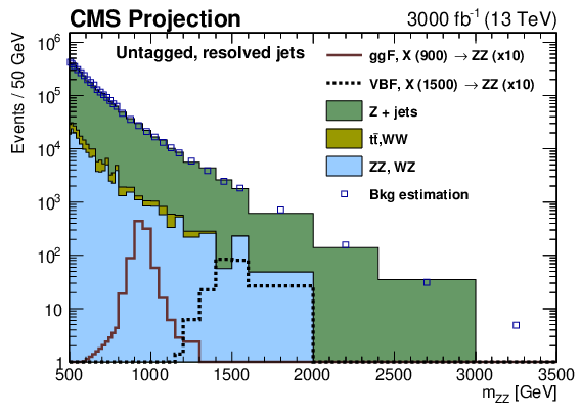
png pdf |
Figure 1-b:
Distributions of the invariant mass mZZ in the signal region expected at 3000 fb−1, for the merged (left) and resolved (right) case in the different categories. The stacked histograms are the expected backgrounds from simulation. The blue points refer to the sum of background estimates derived from control samples. Examples of a 900 GeV ggF signal and a 1500 GeV VBF signal are given. The cross section corresponds to 10 times the excluded limit. |
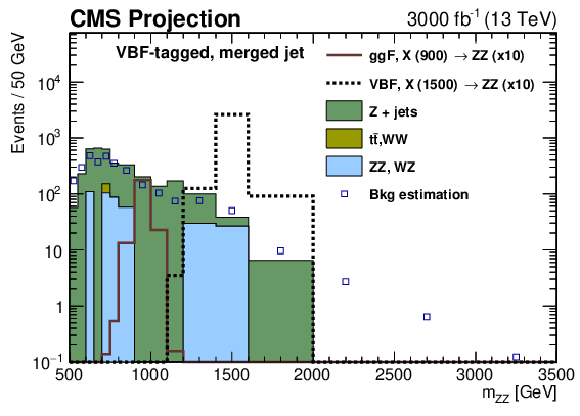
png pdf |
Figure 1-c:
Distributions of the invariant mass mZZ in the signal region expected at 3000 fb−1, for the merged (left) and resolved (right) case in the different categories. The stacked histograms are the expected backgrounds from simulation. The blue points refer to the sum of background estimates derived from control samples. Examples of a 900 GeV ggF signal and a 1500 GeV VBF signal are given. The cross section corresponds to 10 times the excluded limit. |
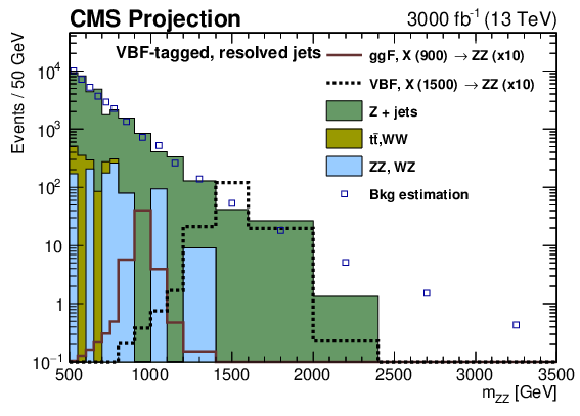
png pdf |
Figure 1-d:
Distributions of the invariant mass mZZ in the signal region expected at 3000 fb−1, for the merged (left) and resolved (right) case in the different categories. The stacked histograms are the expected backgrounds from simulation. The blue points refer to the sum of background estimates derived from control samples. Examples of a 900 GeV ggF signal and a 1500 GeV VBF signal are given. The cross section corresponds to 10 times the excluded limit. |
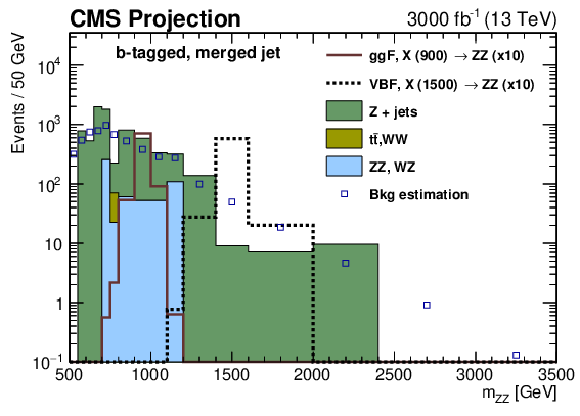
png pdf |
Figure 1-e:
Distributions of the invariant mass mZZ in the signal region expected at 3000 fb−1, for the merged (left) and resolved (right) case in the different categories. The stacked histograms are the expected backgrounds from simulation. The blue points refer to the sum of background estimates derived from control samples. Examples of a 900 GeV ggF signal and a 1500 GeV VBF signal are given. The cross section corresponds to 10 times the excluded limit. |
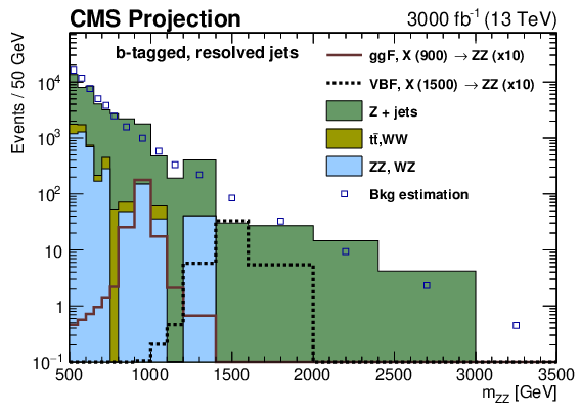
png pdf |
Figure 1-f:
Distributions of the invariant mass mZZ in the signal region expected at 3000 fb−1, for the merged (left) and resolved (right) case in the different categories. The stacked histograms are the expected backgrounds from simulation. The blue points refer to the sum of background estimates derived from control samples. Examples of a 900 GeV ggF signal and a 1500 GeV VBF signal are given. The cross section corresponds to 10 times the excluded limit. |
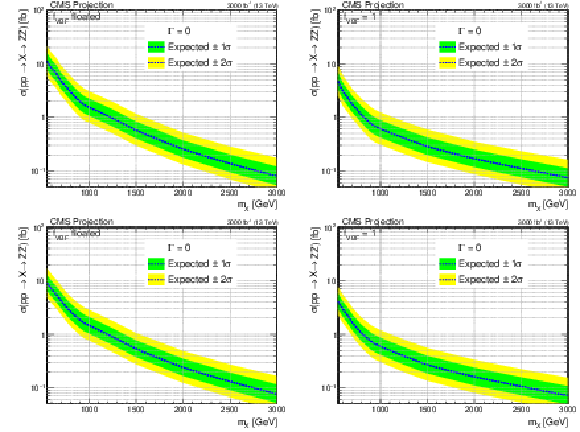
png pdf |
Figure 2:
Expected upper limits at the 95% CL on the pp→X→ZZ cross section as a function of mX, with fVBF as a free parameter (left) and fixed to 1 (right). Scenario 1 (top) and scenario 2 (bottom) are shown. The scalar particle X is assumed to have a narrower decay width than the detector resolution. The results are shown for the 2ℓ2q channel. |
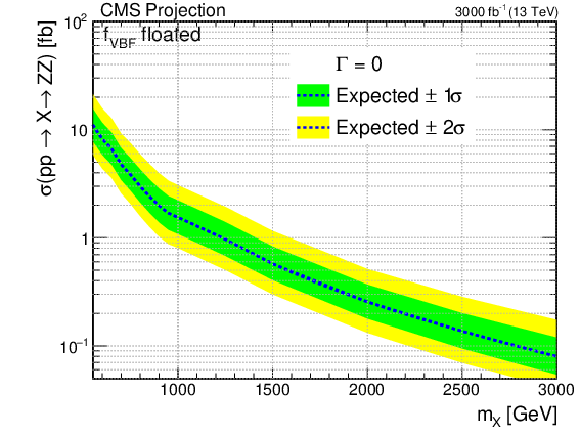
png pdf |
Figure 2-a:
Expected upper limits at the 95% CL on the pp→X→ZZ cross section as a function of mX, with fVBF as a free parameter (left) and fixed to 1 (right). Scenario 1 (top) and scenario 2 (bottom) are shown. The scalar particle X is assumed to have a narrower decay width than the detector resolution. The results are shown for the 2ℓ2q channel. |

png pdf |
Figure 2-b:
Expected upper limits at the 95% CL on the pp→X→ZZ cross section as a function of mX, with fVBF as a free parameter (left) and fixed to 1 (right). Scenario 1 (top) and scenario 2 (bottom) are shown. The scalar particle X is assumed to have a narrower decay width than the detector resolution. The results are shown for the 2ℓ2q channel. |

png pdf |
Figure 2-c:
Expected upper limits at the 95% CL on the pp→X→ZZ cross section as a function of mX, with fVBF as a free parameter (left) and fixed to 1 (right). Scenario 1 (top) and scenario 2 (bottom) are shown. The scalar particle X is assumed to have a narrower decay width than the detector resolution. The results are shown for the 2ℓ2q channel. |

png pdf |
Figure 2-d:
Expected upper limits at the 95% CL on the pp→X→ZZ cross section as a function of mX, with fVBF as a free parameter (left) and fixed to 1 (right). Scenario 1 (top) and scenario 2 (bottom) are shown. The scalar particle X is assumed to have a narrower decay width than the detector resolution. The results are shown for the 2ℓ2q channel. |
| Tables | |

png pdf |
Table 1:
The sources of systematic uncertainty where minimum values are applied in ''YR18 systematics uncertainties'' scenario. Systematic uncertainties of the reference Run 2 analysis are described in Ref. [19]. |
| Summary |
| References | ||||
| 1 | S. L. Glashow | Partial-symmetries of weak interactions | NP 22 (1961) 579 | |
| 2 | F. Englert and R. Brout | Broken symmetry and the mass of gauge vector mesons | PRL 13 (1964) 321 | |
| 3 | P. W. Higgs | Broken symmetries, massless particles and gauge fields | PL12 (1964) 132 | |
| 4 | P. W. Higgs | Broken symmetries and the masses of gauge bosons | PRL 13 (1964) 508 | |
| 5 | G. S. Guralnik, C. R. Hagen, and T. W. B. Kibble | Global conservation laws and massless particles | PRL 13 (1964) 585 | |
| 6 | S. Weinberg | A model of leptons | PRL 19 (1967) 1264 | |
| 7 | A. Salam | Weak and electromagnetic interactions | in Elementary particle physics: relativistic groups and analyticity, N. Svartholm, ed., p. 367 Almqvist \& Wiksell, Stockholm, 1968 Proceedings of the eighth Nobel symposium | |
| 8 | ATLAS Collaboration | Observation of a new particle in the search for the standard model Higgs boson with the ATLAS detector at the LHC | PLB 716 (2012) 1 | 1207.7214 |
| 9 | CMS Collaboration | Observation of a new boson at a mass of 125 GeV with the CMS experiment at the LHC | PLB 716 (2012) 30 | CMS-HIG-12-028 1207.7235 |
| 10 | CMS Collaboration | Observation of a new boson with mass near 125 GeV in pp collisions at √s= 7 and 8 TeV | JHEP 06 (2013) 081 | CMS-HIG-12-036 1303.4571 |
| 11 | CMS Collaboration | Study of the mass and spin-parity of the Higgs boson candidate via its decays to Z boson pairs | PRL 110 (2013) 081803 | CMS-HIG-12-041 1212.6639 |
| 12 | CMS Collaboration | Measurement of the properties of a Higgs boson in the four-lepton final state | PRD 89 (2014) 092007 | CMS-HIG-13-002 1312.5353 |
| 13 | CMS Collaboration | Constraints on the spin-parity and anomalous HVV couplings of the Higgs boson in proton collisions at 7 and 8 TeV | PRD 92 (2015) 012004 | CMS-HIG-14-018 1411.3441 |
| 14 | ATLAS Collaboration | Evidence for the spin-0 nature of the Higgs boson using ATLAS data | PLB 726 (2013) 120 | 1307.1432 |
| 15 | ATLAS Collaboration | Study of the spin and parity of the Higgs boson in diboson decays with the ATLAS detector | EPJC 75 (2015) 476 | 1506.05669 |
| 16 | G. C. Branco et al. | Theory and phenomenology of two-Higgs-doublet models | PR 516 (2012) 1 | 1106.0034 |
| 17 | C. Caillol, B. Clerbaux, J.-M. Fr\'ere, and S. Mollet | Precision versus discovery: A simple benchmark | EPJPlus 129 (2014) 93 | 1304.0386 |
| 18 | ATLAS Collaboration | Combination of searches for heavy resonances decaying into bosonic and leptonic final states using 36 fb−1 of proton-proton collision data at √s= 13 TeV with the ATLAS detector | PRD98 (2018), no. 5, 052008 | 1808.02380 |
| 19 | CMS Collaboration | Search for a new scalar resonance decaying to a pair of Z bosons in proton-proton collisions at √s= 13 TeV | JHEP 06 (2018) 127 | CMS-HIG-17-012 1804.01939 |
| 20 | CMS Collaboration | Technical Proposal for the Phase-II Upgrade of the CMS Detector | CMS-PAS-TDR-15-002 | CMS-PAS-TDR-15-002 |
| 21 | CMS Collaboration | The Phase-2 Upgrade of the CMS Tracker | CMS-PAS-TDR-17-001 | CMS-PAS-TDR-17-001 |
| 22 | CMS Collaboration | The Phase-2 Upgrade of the CMS Barrel Calorimeters Technical Design Report | CMS-PAS-TDR-17-002 | CMS-PAS-TDR-17-002 |
| 23 | CMS Collaboration | The Phase-2 Upgrade of the CMS Muon Detectors | CMS-PAS-TDR-17-003 | CMS-PAS-TDR-17-003 |
| 24 | CMS Collaboration | The Phase-2 Upgrade of the CMS Endcap Calorimeter | CMS-PAS-TDR-17-007 | CMS-PAS-TDR-17-007 |
| 25 | CMS Collaboration | The CMS Experiment at the CERN LHC | JINST 3 (2008) S08004 | CMS-00-001 |
| 26 | G. Apollinari et al. | High-Luminosity Large Hadron Collider (HL-LHC) : Preliminary Design Report | ||
| 27 | CMS Collaboration | Expected performance of the physics objects with the upgraded CMS detector at the HL-LHC | CDS | |
| 28 | T. Junk | Confidence level computation for combining searches with small statistics | NIMA 434 (1999) 435 | hep-ex/9902006 |
| 29 | A. L. Read | Presentation of search results: The CLs technique | JPG 28 (2002) 2693 | |
| 30 | G. Cowan, K. Cranmer, E. Gross, and O. Vitells | Asymptotic formulae for likelihood-based tests of new physics | EPJC 71 (2011) 1554 | 1007.1727 |

|
Compact Muon Solenoid LHC, CERN |

|

|

|

|

|

|